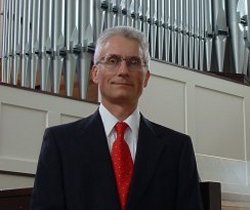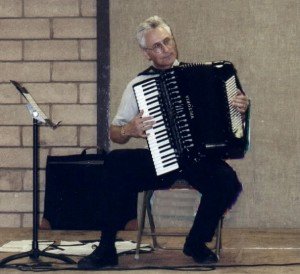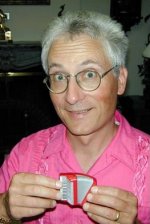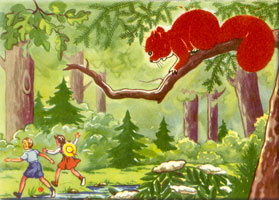
| | Organist | Accordionist | Composer | Conductor | Author | Educator |

 |
Henry Doktorski
|
 |
August 2002: Henry Doktorski performed four solo accordion recitals in Northern California during the end of July, 2002. The concerts were sponsored by Major Accordion Performers (MAP) and tickets were $10.
His itinerary consisted of the following:
His program consisted of the following transcriptions and original works for accordion:
- Friday, July 26: Herman Sons Hall, Petaluma; 7:30 PM
- Saturday, July 27: Colma Moose Club (south of San Francisco); 8 PM
- Sunday, July 28: Seventh Day Adventist Church, San Jose; 2 PM
- Monday, July 29: Community Center, Escalon (near Modesto); 6 PM.
Composer Time Period Composition Johann Ludwig Krebs 1713-1780 Prelude on "Christ lag in Todesbanden" George Friedrich Handel 1685-1759 Suite for a Musical Clock Robert Schumann 1810-1856 Traumerei (from Kinderscenen) Johannes Brahms 1833-1897 Hungarian Dance No. 5 Bela Bartok 1881-1945 Rumanian Folk Dances Vittorio Monti 1868-1922 Czardas Alan Hovhaness 1911-2000 Suite for Accordion Alan Hovhaness Hymn (written for Henry Doktorski) Astor Piazzolla 1921-1992 Oblivion Stanley & David Darrow b. 1933, b. 1963 Meteor Showers Willard A. Palmer 1917-1996 Chorale on "Old Hundreth" Henry Doktorski b. 1956 Rondo Polska
Intermission
Pietro Frosini 1885-1951 Rag in Dm Florette Omaggio a Pietro Guido Deiro 1888-1950 Deiro Rag Musketeers Deirina Mazurka I Don't Care Polka Lido Tango Queen of the Air Valse Caprice No. 1 Neapolitan Polka My Florence Egypto
Doktorski said, "It was especially appropriate that nearly half of my program consisted of works by the great Italian-American accordion pioneer of the early twentieth-century: Guido Deiro, as he spent much of his life in Northern California. He was the greatest exponent of the piano-accordion on the vaudeville stage; he traveled across the United States dozens of times between 1910 and 1930 and also performed in vaudeville houses in Australia and Europe. During this time Guido was actually more popular than his younger brother Pietro, who learned how to play the piano-accordion from his older brother Guido.

Performing at the Escalon Community Center.
Photo by Sunita Doktorski"When the age of vaudeville ended during the Great Depression, Guido settled in San Francisco. Although Deiro continued to play vaudeville shows until at least 1935, after 1929 he traveled less and focused his career on the West Coast. He always had an affinity for the Northwest, spending his vacations in the rugged Northern California and Southern Oregon forests hunting and fishing. Britenbush Hot Springs in Oregon was one of his favorite haunts. He even wrote a march of the same name. Another composition, Under Western Stars, was written while camping."
Doktorski continued, "In the late Twenties Deiro opened a studio and accordion distributorship on Columbus Avenue in San Francisco and from there branched out into Northern California, Nevada, Oregon and Washington, at one time having over two dozen franchised studios. Some of the older residents of San Francisco still remember hearing Guido play. It was a great pleasure for me to present ten classic Guido Deiro compositions during my 2002 California tour."
A compact disc titled California Accordion Recitals was released to coincide with the tour. For more information about the CD, go to California Recitals CD.
While in California, Doktorski played at three other venues: 1. on July 27 a performance of the avant garde accordion solo, Meteor Shower, by Stanley and David Darrow for a movie about the accordion written and directed by independent film producer Steve Mobia, 2. a house concert sponsored by Doktorski's hosts John and Valerie Kieser of Oakland on July 30, and 3. a mini-recital for the Bay Area Accordion Club meeting on August 7.

This toy accordion actually plays "Oh Susanna."
Photo by Valerie KieserBetween July 30 and August 7, Henry took his two children on a week-long camping trip and tour of central California, visiting Yosemite and Sequoia National Parks, Hearst Castle, and enjoying the scenic drive north on route one between Cambria and San Francisco.
Doktorski said, "I was really hoping to see a bear in Sequoia National Park, as the rangers emphatically warned us to lock up our food securely, and our next door neighbors at the campsite had seen six bears the previous day. Although I kept my eyes and ears open for two days and nights while visiting the forest of giant trees, I did not see one bear.
"However, I was almost killed by another wild creature living in the forest! The last morning, while walking back to our site from the latrine, I passed under a huge Ponderosa pine tree. I heard a curious rustling sound high above my head, stopped in my tracks, and tilted my head up and back toward the direction of the sound. I saw a large projectile about the size of a large coconut hurtling down from the top of the tree straight at my face. Instinctively I stepped aside with less than a fraction of a second to spare as the projectile narrowly missed my cranium and crashed with a loud 'whack' on the forest floor. It was a large and heavy (maybe four or five pounds) green pine cone with sharp spines protruding and profuse sap oozing.
"I looked up at the top of the tree. At first I could see nothing unusual, but after a few moments noticed a shaking branch maybe 50 feet above my head. A tiny squirrel (chickaree) peeked its head over the foliage and chattered, seemingly laughing at me in squirrel language: 'Awwww, shucks. I missed.'"

This story was corroborated by William C. Tweed, who wrote in Sequoia & Kings Canyon: The Story Behind the Scenery (1997: KC Publications, Inc.), p. 18: "From the forest comes the agitated chirp of the chickaree, a tree squirrel. . . he hops to the massive base (nearly 30 feet across) of a towering, cinnamon-colored tree. It does not matter to the chickaree that the fibrous bark he climbs belongs to one of the oldest and largest living things on earth and that the branch he carefully selects is . . . over 100 feet off the ground. All that matters to the chickaree is the numerous . . . green cones he finds near the end of the branch. He works rapidly and intently, severing the cones at the rate of one per second. As they are cut, the hard cones land with gentle thuds in the thick forest carpet far below."
Doktorski commented, "Gentle thud, my eye! That is unless the cone lands with a loud 'crack' on the head of an unsuspecting camper below. I'm lucky that I didn't end up in the emergency room of a hospital."

To read a review of Doktorski's California concerts, go to The Classical Free-Reed, Inc. website.
Image of the squirrel from Chickaree, the Fuzzy Wuzzy Squirrel (1948), courtesy of Gregg Elovich.
|